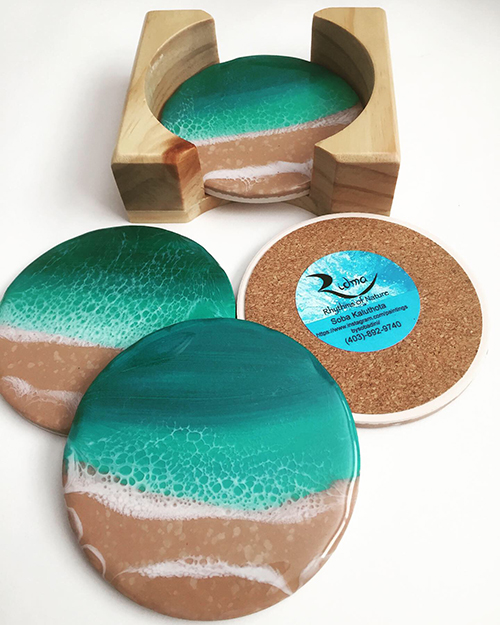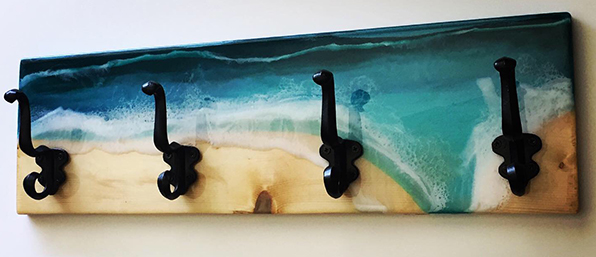By day, you’ll find Soba Kaluthota teaching statistics to first-year Environmental Science students or with colleagues in the Aquaculture Centre of Excellence where, as a researcher, she analyzes the nutrient content in water samples as researchers look to turn fish waste into liquid fertilizer.

Number crunching isn’t for everyone, and even someone who loves data, as Kaluthota does, needs a break sometimes. That’s where her art comes in – creating usable, practical pieces like clocks, stools and charcuterie boards that feature glistening images of sandy beaches, frothy surf and sea turtles, in a glossy, hardened layer of epoxy resin. Some are two dimensional. Others have the added dimension of shells, figurines or pebbles.
Kaluthota, her husband, Chinthaka, and two daughters, then aged three and one, moved to Lethbridge in 2010 from Columbo, the capital of Sri Lanka. The Indian Ocean was just a 15-minute drive from her home.
Her art captures the beauty of the ocean she misses, created with unique paint colours (combinations of powered pigment, acrylic paint and alcohol ink) she can’t exactly replicate from one batch to another. As a result, each piece is unique, preserved forever in a high gloss, non-degradable plastic. As an environmentally-minded scientist, she does have some regret about bringing plastic into the world, but she tempers it with the fact her art has purpose in people’s homes and can help foster an appreciation for the natural world she replicates.

With degrees in forestry and environmental sciences, and chemistry, from Sri Lanka, and a master’s in tree physiology from the University of Lethbridge, Kaluthota started working at Lethbridge College in January 2016.
Learning to teach for the first time, balancing commitment to her class and a research team, while juggling family commitments and adjusting to life in a new country, art was a critical stress reliever, helped along by her introduction to the Lethbridge Artists Club. The club was a conduit to new friends in the community and facilitated exhibitions of her work locally and in the Jubilee Auditorium in Calgary. She serves on the club’s board.
“I’ve been painting as long as I can remember,” Kaluthota says. “I used to do a lot of fabric paintings. My kids still have pillowcases that I painted with different cartoon characters.” Growing up in Sri Lanka, art was infused in the culture. Murals cover the walls of modern cities, rock art depicts the island’s ancient history, and Buddhist temples feature paintings telling the stories of the faith.
“Painting is my stress reliever,” she says. “If I have free time and I’m doing nothing, then I think about my problems. I don’t want that, so I always keep myself busy.”
This fall, she got busy creating art for the Lethbridge Handmade Market held most recently in October, and repeating every second month. Look for her at the next market Dec. 12.
 “I don’t have a separate studio space at home,” she says. “My ‘studio’ is my dining table and kitchen table. I do everything in a week before the sale. For a week, my house is a mess and I have stuff everywhere.”
“I don’t have a separate studio space at home,” she says. “My ‘studio’ is my dining table and kitchen table. I do everything in a week before the sale. For a week, my house is a mess and I have stuff everywhere.”
For beginners, she doesn’t suggest leaping into epoxy art, because resin is expensive. Instead, she suggests starting with acrylic pouring. All you need is acrylic paint (dollar store supplies work just fine), canvas and a pouring medium.
Her epoxy art requires a more solid canvas. Her most popular creations are charcuterie boards for adults and trinket dishes, which she uses as giveaways at her shows. She’s experimenting with painting other surfaces, including wine glasses.
“What I really love about art is seeing people’s reaction to it.”
How to get started:
- Don’t talk yourself out of trying it by saying you can’t draw. “All you have to do is mix four different colours, pour it onto a canvas and then swirl it. Anyone can do it.” Whatever you create will be one of a kind.
- Start with dollar store canvases and craft paints. With red, blue, yellow, black and white craft paint, you’ll be amazed at the colours you can mix. Once you discover you enjoy the art form, you can purchase other acrylic paints.
- You will want to purchase pouring medium, labelled as transparent and gloss. It thins your paint to a pourable consistency and because it’s transparent and gloss, your paint will retain its colour and dry to a shiny finish. You can also thin your paint to a pouring consistency using water, but this will dilute your colour. Start out with these basic inexpensive materials to get a feel for acrylic pouring.
- If you enjoy your small projects, there are additional materials to consider, such as gesso (a canvas primer) and gel medium (to add volume to your paint while maintaining rich colour). You can find an explanation of these things on a how-to video she did for Shaw TV.
- Consider joining the Lethbridge Artists Club to meet others who are interested in art. You’ll meet great people (at a safe distance) and be inspired to try new things. Kaluthota is on the board.
